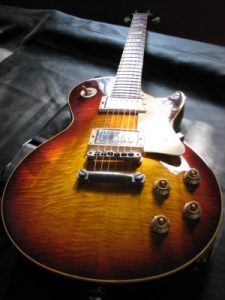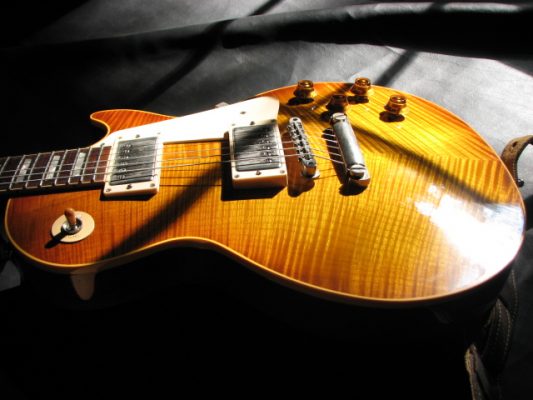Remember when you were a teenager? Take a minute and think back to the days of summer breaks and teenage rebellion. When the only things that mattered were having fun with your friends and avoiding your parents. Now think of your favorite songs from those days. The bands that wrote, recorded, and toured, playing those songs live to millions of people every night, year after year. These are the songs that inevitably began the soundtrack of your life. Now, many years later the music lives on and hopefully many of your favorite artists are still alive and creating. That being said, one thing is certain. Some of those musicians aren’t here anymore. Did you ever wonder what happened to the instruments they used to record and play those famous songs that will live on forever? Did family members end up with them? Maybe friends, museums, odd beneficiaries, auction houses, estate sales?
Decade after decade, the travels and history pertaining to some of the most important and highly collectible music icons gets shrouded in mystery as each year passes. Sometimes these historically significant, extraordinarily valuable musical instruments just fade away. Occasionally they get broken, burned, or parish in some way, and sometimes they get stolen. This brings me to one of the most sought after guitars of all time. Eric Clapton’s late 50’s Gibson Les Paul Standard with a cherry sunburst finish. The exact year of the guitar is not known to anyone, even Clapton himself. This was a guitar he had to have after seeing one of his heroes playing one. It is not known whether it was a 1958, ’59, or ’60 model. He used it to record and play live with John Mayall’s Bluesbreakers. One day in June, 1965, it was stolen from his rehearsal space with his new band, Cream. The main guitar played by one of the world’s most popular and important musicians of the day was gone forever. It was never to be found again and has been referred to as “the million dollar Les Paul”. It has been mentioned in collector’s books, countless other publications and every which way online, but it has never surfaced. While searching for a replacement, and because manufacturing of this particular model had temporarily ceased in 1961, it is believed that Mr. Clapton borrowed a replacement from his friend Keith Richards, who was on tour in the U.S. with the already world famous Rolling Stones. The replacement was a 1959 cherry burst Les Paul. In September, 1966, after many phone calls and lots of persuasion, Clapton managed to purchase a 1958 Les Paul from Andy Summers, who went on to play in The Police. This fact, along with Clapton’s ongoing status as a true pioneering guitar hero that remains revered as one of the all time greatest guitarists to this day, have made this the most valuable guitar on the planet.
There is however, another major contributing factor to this particular guitar being held in such high regard and outrageous value. The guitar itself wasn’t just another Gibson or just another Les Paul model, it was a late ‘50’s Les Paul burst. What is known as a “’58 burst” is the holy grail of all guitars, but a ’58, ‘59’, or ’60 Les Paul are the most sought after of all brands or styles. This is the guitar most serious collectors and dealers travel far and wide for, searching and hunting to find just one. Gibson introduced the first Les Paul model in 1952. It was designed by Ted McCarty and his design team to rival Fender’s hot new single cutaway electric guitar, the Telecaster. Once a prototype was complete, McCarty and Les Paul’s business manager met in Stroudsburg, Pa. with Les, who was the most popular, and highest paid guitarist of the times, and his wife, Mary Ford. The deal was, if he liked it, they would put his name on the guitar and it would be called the “Les Paul” model. He instantly loved it and the rest is history. It came with a gold finish, known as a “gold top”. Without getting too technical, it underwent several changes in ’54, then again in ’56. It wasn’t until 1958 that the real magic happened. Not only was the hardware design just right, the pickups and electronic design absolutely perfect, but the wood they used that year and the decision to stray from classy looking gold or black finishes and introducing the first sunburst Les Paul was all new. Lastly, on top of everything else, the stain and finish details were something to behold on the original 1958, ’59, and ’60 Les Paul guitars produced at Gibson’s 225 Parsons St., Kalamazoo, Michigan plant. Of course they didn’t know this at the time and sales of what would become the almighty sunburst Les Paul dropped so drastically that they actually discontinued production. Gibson even changed the shape of the guitar and Mr. Les Paul himself disliked them so much that he had his name taken off of the new style Les Paul guitars. At that time, the new shape was renamed the “SG”, meaning “solid guitar”. Since then, many famous and world-renowned guitarists have sworn by the SG. Some people love them all. Guitars are like the old saying, “To each his own”.
Fast forward twenty five years after those days of care free teenage fun. Now you’ve got your own rebellious young adult in training and he or she wants to play guitar. Your budding rock star doesn’t want just any guitar, but a real Gibson Les Paul. The same instrument played by their music hero, who, as your child has pointed out several times, actually happens to be a fan of your music heroes. Eventually you’re pestered into submission via Christmas or birthday present. You decide to do some research on the internet, then you will actually make a visit to that guitar store you’ve driven past so many times. Once inside, you’re overwhelmed with the many different shapes, colors, and most of all, the prices. A guy wearing a button down shirt with rolled up sleeves and tattooed arms walks up and asks if you’re looking for anything in particular. On the drive over you were full of questions and now that you’re there, you’re drawing a blank. You look down and see a guitar that has a price tag of $150.00, then look up and see what appears to be the exact same guitar, only this one is on the wall behind the counter and it costs $2,500. Realizing the guy that asked if you needed help is still standing there; you tell him your situation. Before you get too deep into shopping, you want to know exactly why the guitar you’re standing next to and what appears to be the same thing on the wall behind the counter has well over a $2,000.00 price difference. He explains that one is made in America with high quality parts and woods, while the other is made in China with what looks like real wood and cheap parts. He asks how old your child is and what kind of music they listen to. You tell him and add that the only guitar on the list is a real Gibson Les Paul. His eyes light up and his eyebrows rise with a smile because that’s his favorite guitar too. He goes on to explain that, while it’s an expensive guitar for anyone, much less a beginner, it’s American made and will hold it’s value should your teenager lose interest down the road. To get the best value, he says he can get you a used one at a much lower price than a new one if you’ll give him a few days to find a lower end model. You discuss pricing and tell him you’ll think about it. On the way out you thank him for his help before leaving to contemplate this whole experience.


On the way home you remember that your co-worker’s birthday is coming up. While contemplating what to buy her, you recall that she collects vintage clocks. Immediately, you see a Goodwill store and decide to go inside and look for an old clock. You browse around the store for a few minutes and don’t find any clocks. As you’re heading toward the door to leave, you see a beat up old guitar case sitting against the wall near some paintings. Your first thought is that it’s empty and just the case is for sale. Your second thought is that it must be a toy or some plastic guitar for a child. Nevertheless, you walk over and kneel down to open it. You carefully snap open the rusty latches and use both hands to lift it open. The case is old and you rest the top against the wall to study the guitar. To your surprise, it’s not a toy at all, but a beat up, rather ugly, and definitely old, acoustic guitar. It’s black around the edges and brownish orange toward the center with plastic that resembles a stained glass window and rusty strings. There are scratches, nicks, and dents all over this thing and you can see the wood grain showing through where the finish has worn off in certain areas. Eventually your eyes move from the body, up the neck, to what you recently learned was called the headstock and tuners. At first glance there doesn’t appear to be a brand name on it. A second look reveals some lettering but you can’t make it out, so you take your thumb and dust it off to revel something written in cursive. To your amazement, it reads “The Gibson”. Your heart starts to race as you take the beat up old guitar out of its case to look it over. There are scratches everywhere and the guitar looks like it could’ve belonged to your great grandfather. Near the tuners on the back of the headstock you see “$20” written in black marker. You think about it for a minute, and decide to buy it. Why not? It can’t hurt. You put the guitar back inside its weathered case, make sure the latches are closed tight, and carry it with two hands as if it were going to fall apart. When it’s your turn in line, you put the beat up old case on the counter. The cashier opens it and looks for the price. You tell her it says $20 on the back. She’s amazed why anyone would want to buy such a beat up old guitar. Seeing an opportunity here, you agree and ask if you can get some sort of discount due to the fact that it is so beat up and in bad shape. She calls her manager over and they discuss it. The manager says you can have it for $12 if that’s fair. You nod in approval, pay for the guitar, and walk out the door with your eyes wide open and your jaw closed tight as you open the car door to rest it on your back seat.
Not exactly sure of what just happened, you decide to pay the guitar store another visit. As you walk through the door carrying a guitar case, the same guy you spoke to earlier is on the phone, but has a somewhat disappointed look on his face when he sees you with your guitar. When he gets off the phone he asks you what’s in the case. You proceed to tell him how you accidentally stumbled upon an old Gibson guitar and would like him to appraise it. The look of disappointment slowly vanishes from his face as he puts the case on his counter and opens it rather quickly. He stares at it for a minute. Then looks at it left to right, front and back, up and down. You can see he’s starting to bite his lip and then he looks you straight in the eye. He asks how much you paid for it and you tell him it was $12. The guy takes his hat off, runs his hand through his short brown hair and tells you that was the deal of the century. It’s a very rare Gibson L-00 model from the early 1930’s. 1932 he thinks. You ask, even though it’s beat up, if it’s worth anything. He responds with a chuckle and a smile. He says that it’s not beat up; the guitar just has a lot of character. It would take some work to get it in good playing condition again, but afterwards it would be worth about $2,000. This time it’s your eyebrows rising again and you’re happy enough to dance. He proceeds to tell you that it’s the original case as well, and if the guitar were in better condition it could easily sell for triple what it’s worth now. He asks if you’d want to trade your $12 guitar for a used Gibson Les Paul on the wall behind the counter. Unsure if this is a good deal or if he’s being truthful about the value of your find, you silently weigh your options and look at the guitars behind him. He points at two beautiful guitars over his shoulder, both priced at $1,800 and says you can pick either one. You tell him you’ll do it. Why not, right? After you agree, he tells you to pick out a strap and some picks for your youngster to get started with, free of charge. You ask about an amplifier and of course he has the perfect amp. He goes on to explain tubes versus solid state and loses you on the second sentence, but it sounds like he’s saying tube amps are better. He’ll sell you a small tube amp made by a friend of his right here in Raleigh, North Carolina for about $300, or if you want to wait and bring the young guitar player in to pick one out, that’s fine too. As he’s putting your new guitar into its brown case, you decide to wait on the amp and just take the guitar for now. You shake hands and walk out the door with your $12 Les Paul and a confident smile when you picture your child’s face.
When it comes to an old guitar, you can never know everywhere it’s been or pretend to know where it will end up. It could stay in your family forever, or end up in the Smithsonian. Nobody ever really knows, but stories like this do happen. The Raleigh, Durham, and Chapel Hill areas are full of thrift stores, antique shops, and the like. Find them and visit them. You just might get the deal of the century.




